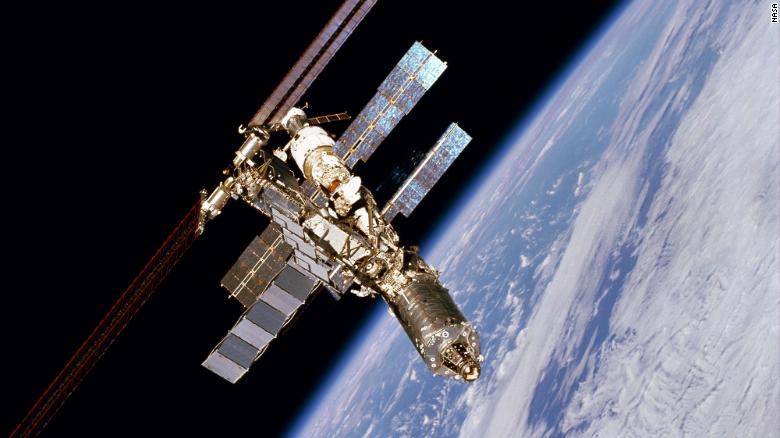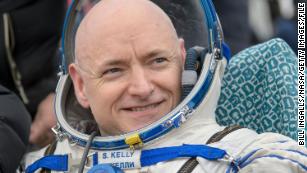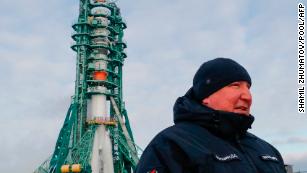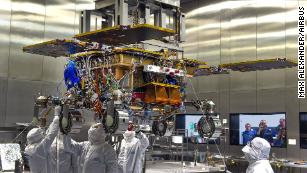By Kristin Fisher and Jackie Wattles, CNN
Mon March 7, 2022

The International Space Station was photographed by one of the STS-98 crew members aboard the Space Shuttle Atlantis following separation of the shuttle and station on February 16, 2001.
(CNN)An extraordinary war of words is transpiring between the head of Russia's space agency and one of NASA's most famous former astronauts as the US-Russian partnership at the International Space Station hits its lowest point since its inception.
Scott Kelly, who famously spent a year in space aboard the station, has been blocked on Twitter by Roscosmos Director General Dmitry Rogozin after Kelly criticized Russia's invasion of Ukraine and Rogozin's repeated threats to pull out of the International Space Station, typically a venue of cooperation immune from geopolitical chaos.

The International Space Station was photographed by one of the STS-98 crew members aboard the Space Shuttle Atlantis following separation of the shuttle and station on February 16, 2001.
(CNN)An extraordinary war of words is transpiring between the head of Russia's space agency and one of NASA's most famous former astronauts as the US-Russian partnership at the International Space Station hits its lowest point since its inception.
Scott Kelly, who famously spent a year in space aboard the station, has been blocked on Twitter by Roscosmos Director General Dmitry Rogozin after Kelly criticized Russia's invasion of Ukraine and Rogozin's repeated threats to pull out of the International Space Station, typically a venue of cooperation immune from geopolitical chaos.
"Get off, you moron!" Rogozin said in a quickly deleted Tweet. "Otherwise, the death of the International Space Station will be on your conscience."
"Dimon, why did you delete this tweet?" Kelly replied in Russian. "Don't want everyone to see what kind of child you are?"
In an interview with CNN, Kelly described it as "the first Twitter argument I've ever had."
Social media propaganda
Kelly said he felt compelled to speak out after Rogozin shared a Roscosmos-produced video showing two Russian cosmonauts floating inside the space station waving goodbye to NASA astronaut Mark Vande Hei, who is supposed to return to Earth with them on a Russian Soyuz spacecraft on March 30.

Expedition 46 Commander Scott Kelly of NASA rested outside of the Soyuz TMA-18M spacecraft minutes after he and cosmonauts Mikhail Kornienko and Sergey Volkov of Roscosmos landed on March 2, 2016, in Kazakhstan.
"If he's going to act like a child, then I'm going to treat him like one," Kelly said. "It's just unimaginable that the Russian space program would leave a person behind in space that they were responsible for bringing home. I don't see that happening."
But Kelly quickly reconsidered after remarking how he also thought it was inconceivable that Russia would launch a full-scale invasion of Ukraine.
"Even though I just said it was unimaginable, maybe they might leave a person behind. I don't know," Kelly said.
There are currently four NASA astronauts, two Russian cosmonauts, and one European Space Agency astronaut living and working aboard the International Space Station. But Vande Hei is the only NASA astronaut featured in the make-believe Roscosmos video.

The head of Russia's Roscosmos space agency, Dmitry Rogozin, stands in front of the Soyuz MS-20 spacecraft at the Baikonur cosmodrome on December 8, 2021.
"If I was him, I would feel like I'm just going to keep doing my job," Kelly said. "And if they (Roscosmos) want to leave me up here, then I'll find another way home."
Kelly, who is fluent in Russian after spending several years training in Moscow's Star City, commends most Roscosmos employees for being "professional, reasonable people" who "want this partnership to continue."
International cooperation
NASA has remained silent on Rogozin's most recent threats to abandon Vande Hei and detach the Russian segment from the space station. But last week, NASA said there were no signs Russia was withdrawing its support from the International Space Station as a result of US sanctions.
"We are not getting any indications at a working level that our counterparts are not committed to ongoing operation on the International Space Station. We as a team are operating just like we're operating three weeks ago," said Kathy Lueders, NASA's associate administrator for space operations.
The space station has been a beacon of international cooperation for more than two decades, and Kelly remains confident it can continue.
"NASA can do really amazing things when they put their minds to it, and I do think they can hold this partnership together," Kelly said.
But he also noted that "sometimes things become more important than spaceflight. In this case, it's Russia waging a war against an innocent country. And if I have the ability to speak up and get attention, and to help the Russian people see the truth, then I'm going to do it."
Ridesharing in space
For nearly a decade, Russia's Soyuz vehicles had been the only means of getting astronauts to and from the space station. But that reliance ended after SpaceX debuted its Crew Dragon capsule in 2020, and the US regained human spaceflight capabilities.
There were, however, tentative agreements for US astronauts to ride on Russian Soyuz vehicles and for Russian cosmonauts to fly with SpaceX in the future. If those agreements fall through, it's not clear if SpaceX will need to reconfigure its schedule to keep enough US astronauts on board the station.
Sign up for CNN's Wonder Theory science newsletter. Explore the universe with news on fascinating discoveries, scientific advancements and more.
Boeing is also working on its own crewed capsule that could be capable of ferrying astronauts to the space station for the United States and its partners. That project, however, is years behind scheduled and beleaguered with hangups. The latest update on that spacecraft came from NASA in January, when NASA and Boeing revealed they were looking toward a May launch of an uncrewed test flight of Boeing's spacecraft, Starliner.
NASA did not immediately respond to a request for comment on future ISS crew transportation matters Monday evening.

No comments:
Post a Comment